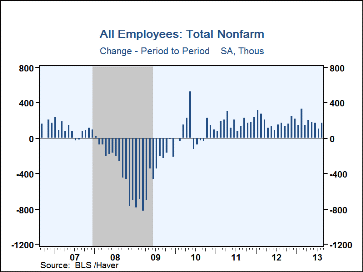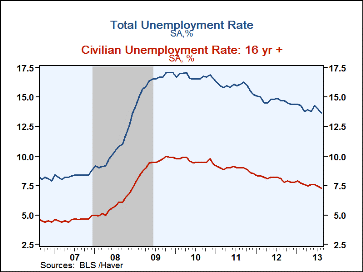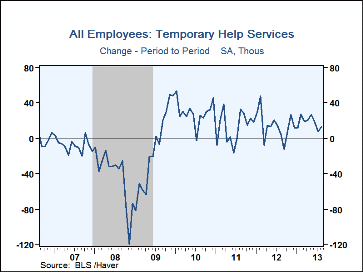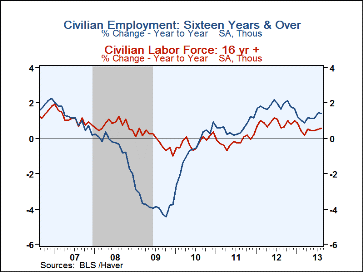 Global| Sep 06 2013
Global| Sep 06 2013U.S. Payroll Employment Gain Moderates; Unemployment Rate Moves Lower
by:Tom Moeller
|in:Economy in Brief
Summary
The labor market continues to firm, but its rate of improvement has toned down of late. Nonfarm payrolls rose 169,000 (1.6% y/y) during August following downwardly revised increases of 104,000 and 172,000 in the prior two months. A [...]
The labor market continues to firm, but its rate of improvement has toned down of late. Nonfarm payrolls rose 169,000 (1.6% y/y) during August following downwardly revised increases of 104,000 and 172,000 in the prior two months. A 177,000 job increase had been expected in the Action Economics survey. Despite these disappointing results, the unemployment rate fell to 7.3%, its lowest level since November 2008. A 7.4% rate had been expected.
From the payroll survey, a 169,000 increase in jobs last month continued the moderation from the 207,000 Q1 average as well as from the high of 262,000 averaged in the first quarter of last year. The 14,000 rise (0.2% y/y) in factory sector employment in August nearly reversed the 16,000 loss of jobs during July. Nevertheless, the trend rate of increase slumped to near-zero from the 2.0% rate of growth early last year. In the construction sector, the weakness has been more pronounced as the level of jobs was unchanged last month (3.0% y/y). That furthers a roughly unchanged reading since March. The average increase in the six months before that was 28,000. Finally, during the last three months, a lessened 58.6% of private industries added to employment, down from a 77.4% high in February of last year.
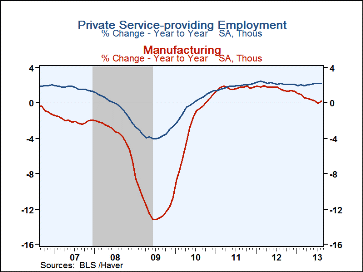 Private service sector job growth also eased. Last month's increase of 134,000 (2.2% y/y) was
the weakest since April and followed a 193,000 Q4'12 average. Slower growth in professional & business
services jobs accounts for much of the slowdown. A 23,000 worker increase (3.4% y/y) last month followed
a 32,000 July gain and a 67,000 average during the first six months of the year. Leisure & hospitality job growth
similarly slowed. Last month's 27,000 job rise (3.1% y/y) was on the heels of a 13,000 July increase but these gains
are stacked against last quarter's 49,000 average. The same moderation is evidenced in health care & social services industries
where jobs grew 38,300 (2.1% y/y) after a slow 14,000 July increase. The Q4 average gain was 36,800. In the retail sector,
job growth actually firmed recently. The 44,000 August increase (2.6% y/y) and a 42,200 July gain were amongst the strongest
of the economic recovery. Temporary help employment grew 13,100 (7.2% y/y), the slowest increase since January.
In the government sector, the employment environment remained stagnant. Last month's 17,000 job rise (-0.4% y/y) followed
declines in the prior three months that were larger than reported initially.
Private service sector job growth also eased. Last month's increase of 134,000 (2.2% y/y) was
the weakest since April and followed a 193,000 Q4'12 average. Slower growth in professional & business
services jobs accounts for much of the slowdown. A 23,000 worker increase (3.4% y/y) last month followed
a 32,000 July gain and a 67,000 average during the first six months of the year. Leisure & hospitality job growth
similarly slowed. Last month's 27,000 job rise (3.1% y/y) was on the heels of a 13,000 July increase but these gains
are stacked against last quarter's 49,000 average. The same moderation is evidenced in health care & social services industries
where jobs grew 38,300 (2.1% y/y) after a slow 14,000 July increase. The Q4 average gain was 36,800. In the retail sector,
job growth actually firmed recently. The 44,000 August increase (2.6% y/y) and a 42,200 July gain were amongst the strongest
of the economic recovery. Temporary help employment grew 13,100 (7.2% y/y), the slowest increase since January.
In the government sector, the employment environment remained stagnant. Last month's 17,000 job rise (-0.4% y/y) followed
declines in the prior three months that were larger than reported initially.
The length of the average workweek held up last month at 34.5 hours and that equaled the average in the first six months of the year. The average workweek in services has been roughly constant at 33.3 hours since early last year and the factory sector workweek held at its high of 40.8 hours. The 39.0 hours worked in the construction sector last month roughly equaled average of the prior nine months.
Picking up slightly last month were averaged hourly earnings. They posted a 0.2% rise after no change in July. The y/y rise in earnings improved to 2.2% and the 2.5% rise during the last three months was firmer. Factory sector earnings have improved the most to a three-month growth rate of 3.2% versus last year's 1.0% advance.
From the household survey, the unemployment rate's decline to 7.3% reflected a 115,000 drop (+1.4% y/y) in employment that was outpaced by a 312,000 shortfall (+0.5% y/y) in the labor force. The labor force participation rate fell to 63.2% which was its lowest level since May 1978. The growth in those not in the labor force was 1.7% y/y after 2.5%-to-3.0% gains during the prior four years. The total unemployment rate including those who are part-time for economic reasons or marginally attached fell to 13.7%, its lowest since December 2008. The average duration of unemployment rose slightly to 37.0 weeks but remained down from the 40.7 weeks in December 2011.
The figures referenced above are available in Haver's USECON database. Additional detail can be found in the LABOR and in the EMPL databases. The expectation figures are from Action Economics and are in the AS1REPNA database.
| Employment: (M/M Chg., 000s) | Aug | Jul | Jun | Y/Y | 2012 | 2011 | 2010 |
|---|---|---|---|---|---|---|---|
| Payroll Employment | 169 | 104 | 172 | 1.6% | 1.7% | 1.2% | -0.7% |
| Previous | -- | 162 | 188 | -- | 1.4 | 1.2 | -0.7 |
| Manufacturing | 14 | -16 | -7 | 0.2 | 1.7 | 1.7 | -2.7 |
| Construction | 0 | -3 | 10 | 3.0 | 2.0 | 0.3 | -8.3 |
| Private Service Producing | 134 | 144 | 188 | 2.2 | 2.2 | 1.9 | -0.1 |
| Government | 17 | -23 | -22 | -0.4 | -0.8 | -1.8 | -0.3 |
| Average Weekly Hours - Private Sector | 34.5 | 34.4 | 34.5 | 34.4 (Aug'12) |
34.4 | 34.4 | 34.1 |
| Average Private Sector Hourly Earnings (%) | 0.2 | 0.0 | 0.4 | 2.2 | 1.9 | 2.0 | 1.8 |
| Unemployment Rate (%) | 7.3 | 7.4 | 7.6 | 8.1 (Aug'12) |
8.1 | 8.9 | 9.6 |
Tom Moeller
AuthorMore in Author Profile »Prior to joining Haver Analytics in 2000, Mr. Moeller worked as the Economist at Chancellor Capital Management from 1985 to 1999. There, he developed comprehensive economic forecasts and interpreted economic data for equity and fixed income portfolio managers. Also at Chancellor, Mr. Moeller worked as an equity analyst and was responsible for researching and rating companies in the economically sensitive automobile and housing industries for investment in Chancellor’s equity portfolio. Prior to joining Chancellor, Mr. Moeller was an Economist at Citibank from 1979 to 1984. He also analyzed pricing behavior in the metals industry for the Council on Wage and Price Stability in Washington, D.C. In 1999, Mr. Moeller received the award for most accurate forecast from the Forecasters' Club of New York. From 1990 to 1992 he was President of the New York Association for Business Economists. Mr. Moeller earned an M.B.A. in Finance from Fordham University, where he graduated in 1987. He holds a Bachelor of Arts in Economics from George Washington University.


